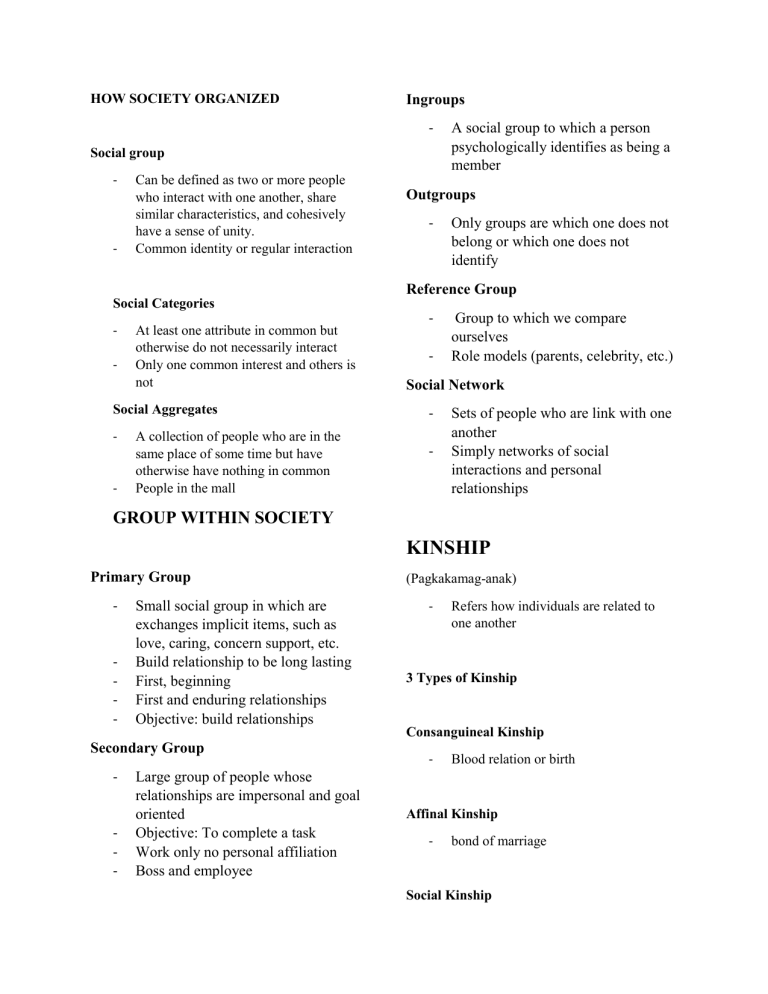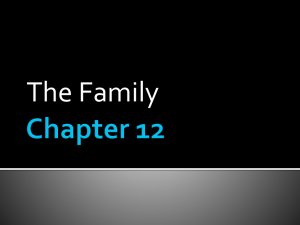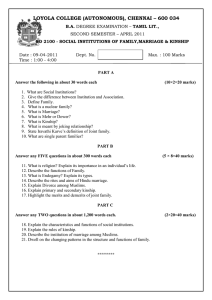
HOW SOCIETY ORGANIZED Ingroups - Social group - - Can be defined as two or more people who interact with one another, share similar characteristics, and cohesively have a sense of unity. Common identity or regular interaction A social group to which a person psychologically identifies as being a member Outgroups - Only groups are which one does not belong or which one does not identify Reference Group Social Categories - At least one attribute in common but otherwise do not necessarily interact Only one common interest and others is not Social Aggregates - - A collection of people who are in the same place of some time but have otherwise have nothing in common People in the mall - Group to which we compare ourselves Role models (parents, celebrity, etc.) Social Network - Sets of people who are link with one another Simply networks of social interactions and personal relationships GROUP WITHIN SOCIETY KINSHIP Primary Group - - Small social group in which are exchanges implicit items, such as love, caring, concern support, etc. Build relationship to be long lasting First, beginning First and enduring relationships Objective: build relationships - - Refers how individuals are related to one another 3 Types of Kinship Consanguineal Kinship Secondary Group - (Pagkakamag-anak) Large group of people whose relationships are impersonal and goal oriented Objective: To complete a task Work only no personal affiliation Boss and employee - Blood relation or birth Affinal Kinship - bond of marriage Social Kinship - individuals are not committed by blood or marriage kinship by Rituals - godparent relationship widely practices godparents being chosen at baptism and marriage kinship by Blood - Endogamy - - - Refers to the socially recognized links between ancestors and descendants or our traceable ancestry Relationship with individual Lineage - Direct descendant from an ancestor or descendant from a common ancestor Maternal or paternal like Unilineal descent is tracing an individual’s descent EITHER through the father or mother’s life Two Basic Form Patrilineal Descent - Makes life, found in male ancestors - Bilateral Descent - Tracing an individual descent through the father AND mother’s life, where our ancestors by blood are considered related Kinship by Marriage Practice of having only one sexual partner at a time Polygamy - Marrying multiple spouses When a man married to more than one wife at the same time, sociologist call this polygyny where a woman is married to more than one husband at a time, it is called polyandry MARRIAGE RULES ACROSS CULTURES Post Martial Residency Rules - Specify where as a person resides after marriage (Neolocal Rules of Residency) Neolocal Residence - Matrilineal Descent -members from a founding female ancestor Called out marriage, a custom enjoining marriage outside own group Monogamy Principle of Descent - Called in marriage, a marriage custom enjoining one to many within one group compulsory Exogamy Descent - A relationship when marriage occurs When a married couple live together in a new residence instead of with the husband’s family or the wife’s family FORMS OF NEOLOCAL RESIDENCE Patrilocal Residence - When a married couple live without near the husband’s family Matrilocal Residence - When a married couple lives with or near the wife’s parents Ambilocal Residence - Married couple lives with or near spouse’s family or alternative between families Referred Marriage - It consists of match makers that help their single friends or relatives to find their possible husband or wife by referring them to another or woman who is also interested in finding a life partner Arranged Marriage - Arranged by the parents and selecting their partner to be married TYPES OF ARRANGED MARRIAGE Child Marriage - Marriage in which one or both of spouses are under 18 years old Family - Household - Exchange spouses between two groups Unit, whether they are related or not Share resources whether they are related or not Types of Family Nuclear Family - Elementary family Parenthood consisting of a pair of adults and their socially recognized children Extended Family - Expansion of the nuclear family Reconstituted Family - Exchange Marriage - Consist of two or more parents with their children Main component: existence of the child - Step family Two families join together after one of both parents have divorce or their previous partner dies Cohabitation Diplomatic Marriage - Arranged for political reasons, to cement alliance POLITICS OF KINSHIP Modern Arrange Marriage - Parents choose several possible mates for the child, sometimes with the help of the child THE FAMILY AND THE HOUSEHOLD Political Dynasty - A political family (also to as a political dynasty) is a family in which several members are involved in politics Political Alliances - Also known as COALITION or BLOC is a cooperation by members of different political parties on a common agenda of some kind POLITICAL AND LEADERSHIP STRUCTURES - State and Nation - Political Organization - Involve itself in politics or political process Any entity or organization in politics or political process 4 Types of Political Organization - - 4 Types of State Population or People - Population in the state If there are no people there is no state Territory It is the smallest unit of political organization, consisting of only a few families and no formal leadership Egalitarian: equal resources Shared to everybody NOMADS Hunter gatherers No leaders No structures Tribes - Most developed structured organization State: centralized government, political concept Nation: to raise people, economic concept ELEMENT OF STATE Bands Monopolized by senior or single person like monarchy It has leaders Has hierarchy Divine right theory Social group compose of chief of numerous families, clans or generation learning a shared ancestry and language No structure or government Economic system Poultry culture Redistribution of foods - Geographic location whether land, air, ocean or space Government - Organizational policies are enforced as well as mechanism for determining policy Sovereignty - - In political theory, the ultimate overseer, or authority in the decision making of the state Supreme power Internal - Chiefdoms Eternal Power of the state to command or rule the within the territory or nation - From external control or formal rule POLITICAL AUTHORITY AND LEGITIMACY Authority - Legitimate power of a person or group over another group Right of power Legitimacy - Right in acceptance of authority Power (Mac Weber) - Capacity of an individual to influence the actions, beliefs or control behavior of others TYPES OF LEGITIMATE AUTHORITY Hereditary Monarchy Traditional Authority - Derived from the norms, custom of an organization Charismatic Authority - Derives from the charisma of the leader Qualities, extra ordinary capabilities Martin Luther (mercy of God) Hitler Rational Legal Authority - Legal legitimacy and bureaucracy BRANCHES OF GOVERNMENT Legislative - Makes Law (congress, house representatives, and senate) Executive - Carries out Laws (president, vice president, cabinet, most of federal agencies) Judicial - Evaluate Laws (supreme courts and other courts) Check and Balance - Through presidential veto Making sure that the different organization in the government will not invade each other’s operations and errands.


